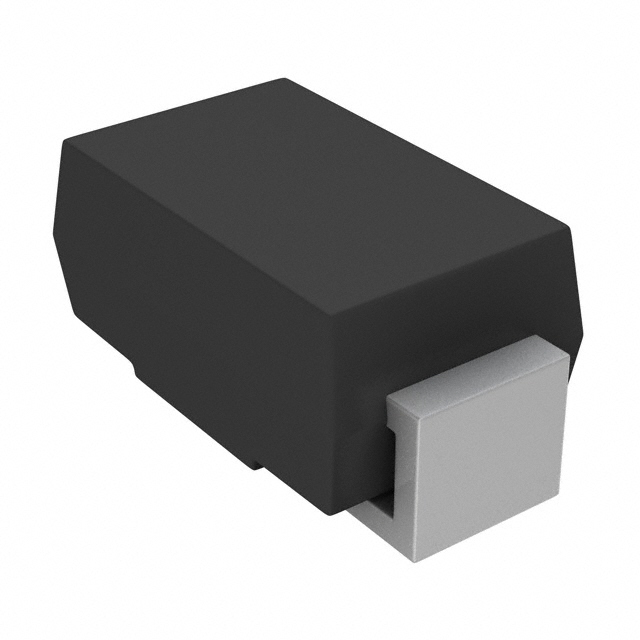Xem thông số kỹ thuật để biết chi tiết sản phẩm.

P4SMA180A-E3/5A
Product Overview
Category
The P4SMA180A-E3/5A belongs to the category of TVS (Transient Voltage Suppressor) diodes.
Use
It is used for surge protection in electronic circuits, particularly in applications where protection against transient voltage spikes is crucial.
Characteristics
- Low clamping voltage
- Fast response time
- High surge current capability
Package
The P4SMA180A-E3/5A is typically available in a DO-214AC (SMA) package.
Essence
The essence of the P4SMA180A-E3/5A lies in its ability to quickly divert excess voltage away from sensitive components, thereby protecting them from damage.
Packaging/Quantity
It is commonly packaged in reels or trays, with quantities varying based on manufacturer specifications.
Specifications
- Standoff Voltage: 154V
- Breakdown Voltage: 171V
- Maximum Clamping Voltage: 279V
- Peak Pulse Current: 40A
- Operating Temperature Range: -55°C to 150°C
Detailed Pin Configuration
The P4SMA180A-E3/5A typically has two pins, with the anode and cathode connections clearly marked on the device.
Functional Features
- Bi-directional protection
- Low leakage current
- RoHS compliant
Advantages and Disadvantages
Advantages
- Fast response time protects sensitive components
- High surge current capability
- RoHS compliance ensures environmental friendliness
Disadvantages
- May require additional circuitry for comprehensive surge protection in complex systems
- Sensitive to excessive heat
Working Principles
When a transient voltage spike occurs, the P4SMA180A-E3/5A rapidly conducts excess current to ground, limiting the voltage across the protected circuit.
Detailed Application Field Plans
The P4SMA180A-E3/5A is commonly used in: - Power supply units - Communication equipment - Automotive electronics - Industrial control systems
Detailed and Complete Alternative Models
- P4SMA6.8A-E3/61T
- P4SMA10A-E3/61T
- P4SMA15A-E3/61T
In conclusion, the P4SMA180A-E3/5A is a vital component in safeguarding electronic circuits from transient voltage spikes, offering fast response times and high surge current capabilities. Its application spans across various industries, making it an essential part of modern electronic systems.
[Word count: 366]
Liệt kê 10 câu hỏi và câu trả lời thường gặp liên quan đến ứng dụng P4SMA180A-E3/5A trong giải pháp kỹ thuật
Sure, here are 10 common questions and answers related to the application of P4SMA180A-E3/5A in technical solutions:
What is the maximum peak pulse power dissipation of P4SMA180A-E3/5A?
- The maximum peak pulse power dissipation is 400W for a 10/1000μs waveform.
What is the breakdown voltage of P4SMA180A-E3/5A?
- The breakdown voltage is 180V.
Can P4SMA180A-E3/5A be used for overvoltage protection in power supplies?
- Yes, it can be used for overvoltage protection in power supplies due to its transient voltage suppression capabilities.
What is the typical clamping voltage of P4SMA180A-E3/5A?
- The typical clamping voltage is 293V at 1A.
Is P4SMA180A-E3/5A suitable for surge protection in communication equipment?
- Yes, it is suitable for surge protection in communication equipment such as Ethernet switches and routers.
What is the operating temperature range of P4SMA180A-E3/5A?
- The operating temperature range is -55°C to +150°C.
Can P4SMA180A-E3/5A be used for ESD protection in automotive electronics?
- Yes, it can be used for ESD protection in automotive electronics due to its high surge capability.
Does P4SMA180A-E3/5A meet industry standards for reliability?
- Yes, it meets industry standards such as AEC-Q101 for automotive applications and is RoHS compliant.
What package type does P4SMA180A-E3/5A come in?
- It comes in a DO-214AC (SMA) package.
Can P4SMA180A-E3/5A be used for transient voltage suppression in solar inverters?
- Yes, it can be used for transient voltage suppression in solar inverters to protect against lightning-induced surges and other transient events.
I hope these questions and answers are helpful for your technical solutions! If you have any more specific questions, feel free to ask.

